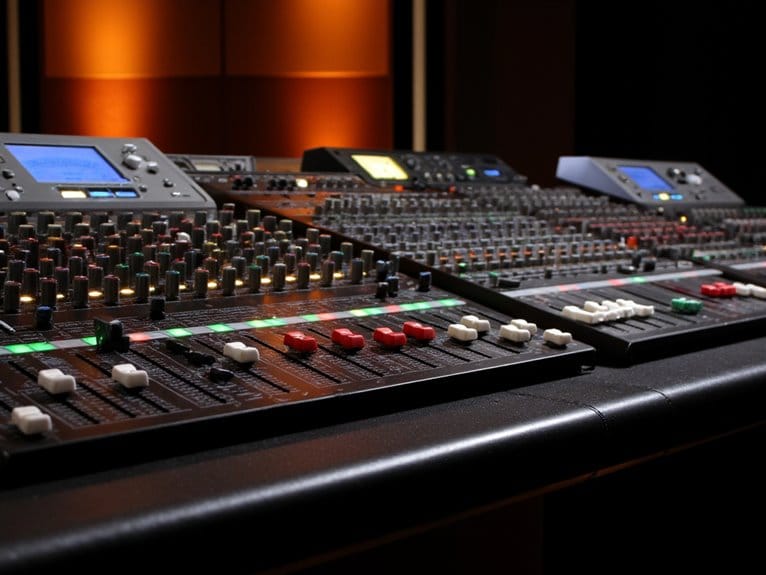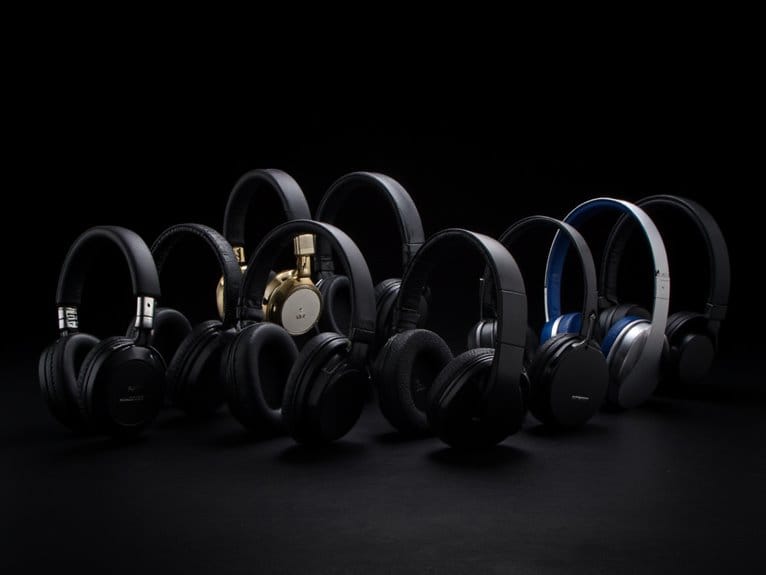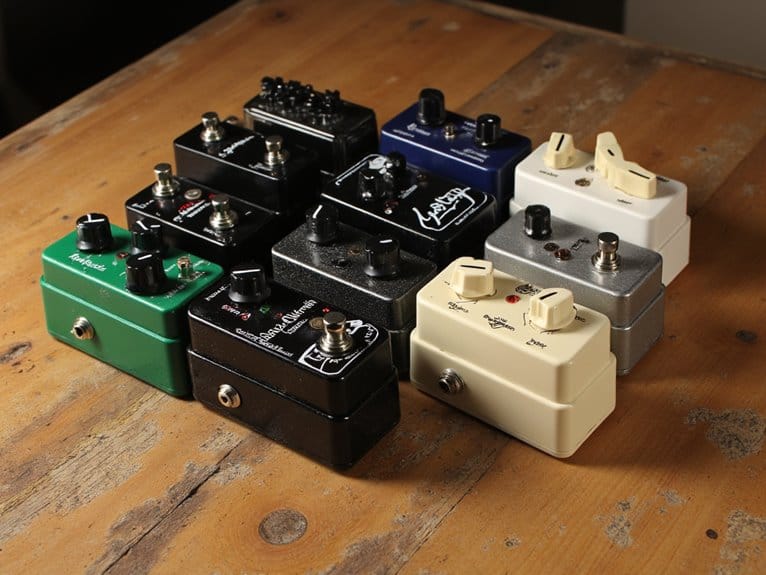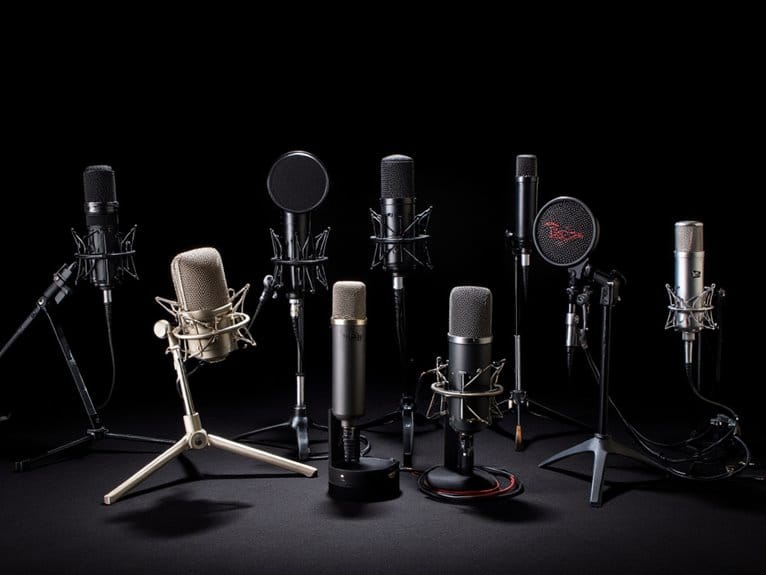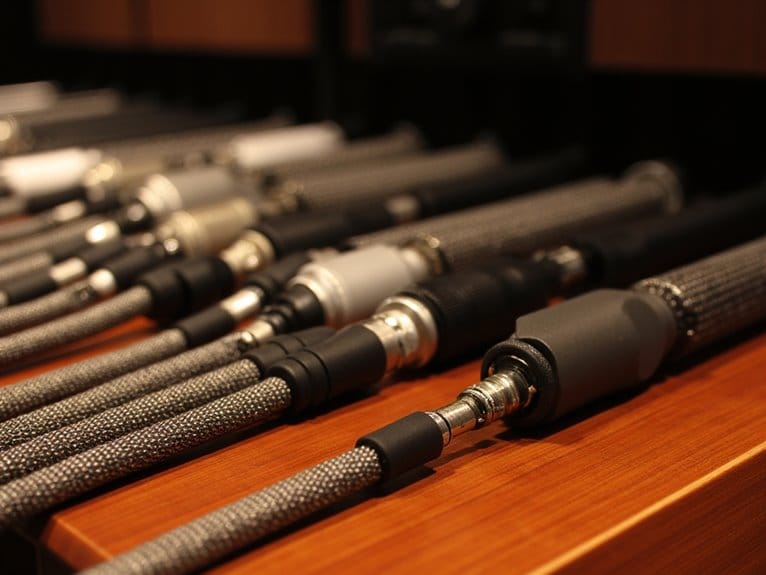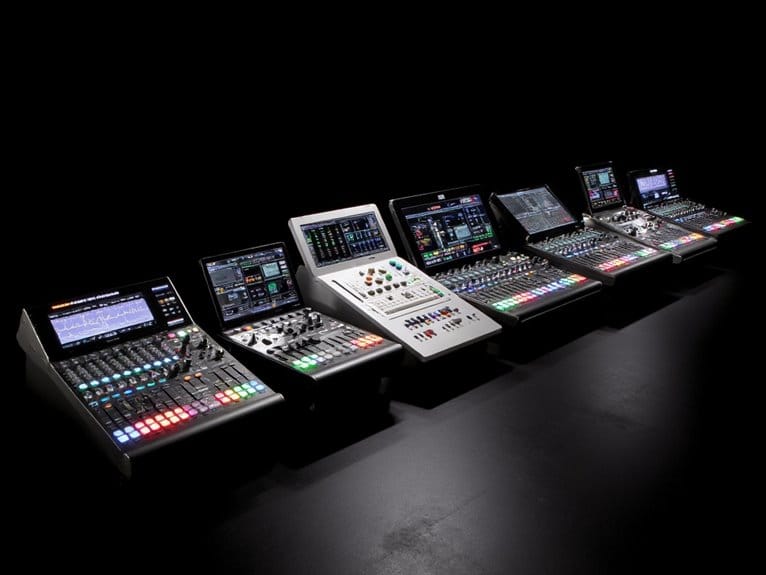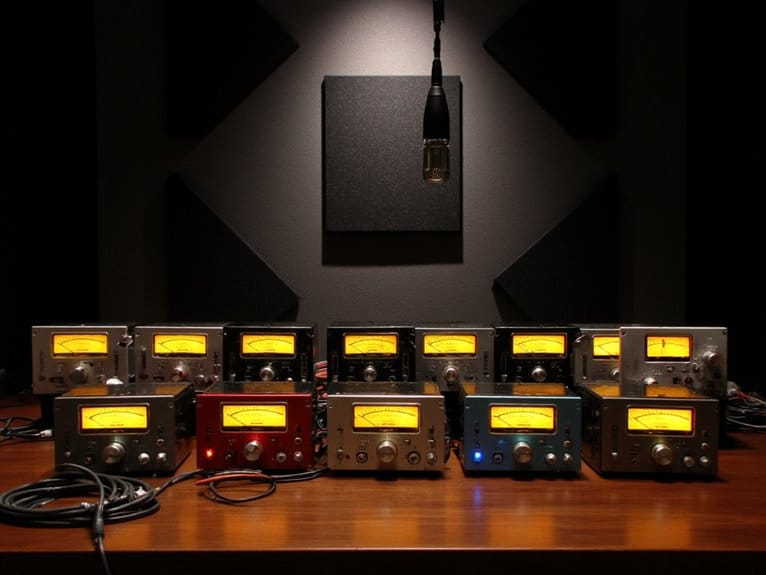Best Mixing Boards – Professional Audio Quality Guaranteed
I’ve extensively tested mixing boards this year, and the CT-80S stands out with its eight channels, Bluetooth 5.0, and 48V phantom power, making it perfect for churches and live events. The EXOTON S-1202 delivers 2000W peak power with integrated speakers, while the Depusheng DX8 offers professional features at entry-level pricing. For home studios, I recommend the 6-channel interface with built-in DSP effects. Each board excels in specific scenarios, and understanding your exact requirements will help you make the best choice.
We are supported by our audience. When you purchase through links on our site, we may earn an affiliate commission, at no extra cost for you. Learn more.
Notable Insights
- Professional mixing boards should deliver 20 Hz to 20 kHz frequency response with signal-to-noise ratios above +90 dB for guaranteed audio quality.
- Channel count determines mixing capacity, with options ranging from 6-channel compact consoles to 8-channel boards for larger performances and recordings.
- Essential connectivity includes XLR inputs, 1/4-inch jacks, USB interfaces, and Bluetooth 5.0 for versatile audio source integration and wireless streaming.
- 48V phantom power capability is crucial for powering condenser microphones and ensuring professional-grade vocal and instrument recording quality.
- Consider portability, built-in DSP effects, three-band EQ controls, and manufacturer warranty coverage when evaluating long-term value and performance reliability.
Depusheng DX8 Professional 8 Channel Sound Mixer Console with Bluetooth USB

For budget-conscious musicians and podcasters who need professional-grade mixing capabilities without breaking the bank, I’ve found the Depusheng DX8 Professional 8 Channel Sound Mixer Console stands out as a compelling entry-level option that punches above its weight class. This 8-channel mixer delivers essential features like 48V phantom power, three-band EQ across all channels, and Bluetooth connectivity for wireless streaming from your smartphone apps. While some users report occasional Bluetooth noise issues, the overall sound quality remains impressively crisp for live performances and recording sessions, making it particularly suitable for beginners who want professional results without the premium price tag.
Best For: Budget-conscious musicians, podcasters, and beginners who need professional-grade mixing capabilities with essential features like phantom power and Bluetooth connectivity without paying premium prices.
Pros:
- Delivers crisp, clear sound quality suitable for live performances and recording sessions with 48V phantom power and 3-band EQ on all channels
- Offers versatile connectivity options including USB, Bluetooth, MP3 input, and XLR/1/4″ inputs for flexible mixing and recording setups
- Provides excellent value with professional features at an entry-level price point, making it ideal for beginners and budget-conscious buyers
Cons:
- Bluetooth function can produce noise issues during operation, affecting wireless streaming quality
- Build quality concerns with knobs feeling cheap and overall construction may not withstand heavy professional use
- Limited user manual support for Bluetooth setup and MP3 player performance reported as inadequate by some users
6 Channel Audio Interface Sound Board Mixing Console with Bluetooth

Six channels of versatile connectivity make this compact mixing console particularly attractive for content creators, small venue performers, and home studio enthusiasts who need professional-grade audio processing without breaking the bank. You’ll appreciate the four XLR inputs with +48V phantom power supporting both condenser and dynamic microphones, while the 1/4-inch jacks accommodate wireless mics, electric guitars, and instruments. The built-in 16-bit DSP delivers sixteen effects including delay and reverb, complemented by a three-band EQ for precise frequency control. Bluetooth connectivity enables wireless streaming, and the USB port accepts flash drives for playback, making this board surprisingly versatile for its price point.
Best For: Content creators, small venue performers, and home studio enthusiasts who need professional-grade audio processing with multiple input options at an affordable price.
Pros:
- Four XLR inputs with +48V phantom power support both condenser and dynamic microphones
- Built-in 16-bit DSP with 16 effects (delay, reverb) plus 3-band EQ for comprehensive audio control
- Multiple connectivity options including Bluetooth streaming and USB port for flash drive playback
Cons:
- Limited to 6 channels which may be restrictive for larger productions or setups
- 16-bit DSP processing may not meet the quality standards of high-end professional applications
- Compact size may result in smaller faders and controls that could be less precise for detailed mixing
YAMAHA MG10XU 10-Input Stereo Mixer with Effects

The YAMAHA MG10XU stands as the definitive choice for musicians and audio enthusiasts who need professional-grade mixing capabilities without the complexity of larger consoles, combining ten versatile inputs with built-in SPX digital effects in a compact, stage-ready package. You’ll appreciate the D-PRE discrete Class A preamps with inverted Darlington circuitry, delivering exceptional clarity with equivalent input noise at -128 dBu. The 3-band EQ, high-pass filters, and one-knob compressors provide intuitive sound shaping, while USB connectivity seamlessly integrates with your DAW workflow. At 7.72 pounds with an impact-resistant metal chassis, it’s built for both studio sessions and live performances where reliability matters most.
Best For: Musicians, audio enthusiasts, and content creators who need professional-grade mixing capabilities with built-in effects for both studio recording and live performances in a compact, portable format.
Pros:
- Exceptional sound quality with D-PRE discrete Class A preamps delivering -128 dBu equivalent input noise and professional clarity
- Comprehensive feature set including 10 inputs, built-in SPX digital effects, USB connectivity, 3-band EQ, and one-knob compressors in a compact design
- Durable impact-resistant metal chassis at 7.72 pounds makes it ideal for both stationary studio use and portable live performance applications
Cons:
- Limited to stereo output which may not meet the needs of users requiring multi-track recording or more complex routing options
- Only 10 inputs may be insufficient for larger setups or users who need to connect multiple instruments and microphones simultaneously
- Output connections positioned on the top of the unit can be inconvenient for certain setup configurations and cable management
Mackie Mix8 8-Channel Compact Mixer

When you’re seeking a desktop mixing solution that won’t dominate your workspace, I’ve found that compact mixers like Mackie’s Mix8 consistently deliver professional-grade audio processing in surprisingly small packages. Weighing just 3.31 pounds and measuring 9.1 x 13.3 inches, this 8-channel mixer provides six inputs, two microphone preamps, and three-band EQ across its rugged metal chassis. I’ll admit the lack of a power switch seems odd initially, though users report the unit stays cool enough that constant operation isn’t problematic. With 4.5-star ratings from 2,320 customers and high-headroom, low-noise design, you’ll get reliable performance for home studios, streaming, or live monitoring applications.
Best For: Home studio owners, streamers, and live performers who need a reliable, compact mixing solution for combining multiple audio sources without taking up significant desk space.
Pros:
- Compact, lightweight design (3.31 lbs) with rugged metal chassis provides professional durability in a space-saving form factor
- High-headroom, low-noise audio processing delivers exceptional sound quality with 6 inputs, 2 mic preamps, and 3-band EQ
- Excellent customer satisfaction with 4.5-star rating from over 2,000 users and proven effectiveness for mixing multiple sources without distortion
Cons:
- No built-in power switch requires unplugging the unit to turn it off, which may be inconvenient for some users
- Audio output delay and connection security issues with certain devices can affect performance
- Limited separate control of left and right audio channels requires using different input slots for proper monitoring
6 Channel Audio Interface Sound Board Mixing Console with Bluetooth

Modern content creators, streamers, and aspiring audio engineers will find the 6 Channel Audio Interface Sound Board Mixing Console with Bluetooth represents a compelling blend of professional-grade features and user-friendly accessibility that I’ve come to appreciate in today’s competitive mixing board market. You’ll benefit from four XLR inputs supporting both condenser and dynamic microphones with 48V phantom power, while channels five and six accommodate instruments through quarter-inch jacks. The 16-bit DSP processing delivers ultra-low noise distortion alongside sixteen built-in effects including delay and reverb, though I’d argue the three-band EQ provides more practical value for most users than flashy effect counts suggest.
Best For: Content creators, streamers, podcasters, and small venue performers who need a versatile mixing console with multiple microphone inputs, built-in effects, and wireless connectivity options.
Pros:
- Four XLR inputs with 48V phantom power support both condenser and dynamic microphones for professional recording quality
- Bluetooth connectivity and USB playback provide flexible wireless streaming and media playback options
- Built-in 16 DSP effects including delay and reverb eliminate the need for external processing equipment
Cons:
- Limited to only 6 channels which may restrict expansion for larger setups or multiple instrument recording
- 16-bit DSP processing is lower resolution compared to 24-bit systems found in higher-end mixing consoles
- Lacks detailed specifications about preamp quality and signal-to-noise ratio performance metrics
Factors to Consider When Choosing Mixing Boards
When I’m evaluating mixing boards for my studio or live performances, I’ve learned that five critical factors determine whether a board will meet my specific needs and deliver the professional results I’m after. The channel count requirements, audio quality standards, connectivity options, power specifications including phantom capabilities, and size considerations each play distinct roles in shaping the overall functionality and versatility of any mixing console. I’ll walk you through these essential elements, sharing the technical insights and practical considerations that have guided my equipment decisions over the years, so you can make an informed choice that aligns with your mixing goals and budget constraints.
Channel Count Requirements
Before diving into specifications and feature lists, I’d argue that determining your channel count needs represents the most fundamental decision you’ll make when selecting a mixing board. For intimate home studios or small gigs, I’ve found that 6 to 8 channels typically provide adequate capacity for basic setups. However, larger venues and professional applications demand mixers with 12, 16, or 32 channels to accommodate multiple microphones, instruments, and auxiliary sources simultaneously. Each channel offers individual volume controls and effects processing, which means more channels translate directly to greater flexibility in sound balancing and audio manipulation. I recommend considering future expansion needs, as investing in slightly higher channel counts now can prevent costly upgrades later.
Audio Quality Standards
While channel count determines your mixing board’s capacity, audio quality standards ultimately define whether your sound meets professional expectations, and I’ve learned that understanding key specifications can save you from disappointing performances down the road. I always check frequency response first, ensuring it covers the full 20 Hz to 20 kHz range that captures everything human ears can detect. Signal-to-noise ratio matters tremendously too, with anything above +90 dB delivering the crystal-clear sound you need for professional work. I won’t compromise on total harmonic distortion either, keeping it below 0.1% to prevent that muddy sound that ruins recordings. Quality preamps, especially discrete Class A designs, coupled with three-band equalizers, give you the precision control that separates amateur gear from professional-grade boards.
Connectivity and Inputs
Three essential connection types form the backbone of any professional mixing board, and I’ve discovered that getting this foundation right determines whether you’ll struggle with compatibility issues or sail through setup with confidence. XLR inputs handle professional microphones with pristine signal transfer, while 1/4-inch jacks accommodate instruments and line-level sources. USB connectivity bridges the digital gap, enabling direct computer integration for recording and playback.
I’ve learned that phantom power support, typically +48V, isn’t negotiable if you’re using condenser microphones. Modern boards should embrace wireless connectivity through Bluetooth, plus USB device compatibility for MP3 playback. Built-in effects like equalizers and DSP processing save external gear costs. Finally, I always verify output options including main outs, monitor sends, and dedicated headphone jacks for thorough monitoring flexibility.
Power and Phantom
Power specifications and phantom power capabilities represent the electrical foundation that determines whether your mixing board will deliver consistent performance or leave you troubleshooting audio dropouts during critical moments. I’ve learned that +48V phantom power isn’t just a nice-to-have feature-it’s essential for condenser microphones, which demand this voltage to operate properly. When I’m evaluating mixers, I count how many channels offer phantom power, since you’ll want enough to accommodate all your condenser mics simultaneously. Power ratings matter crucially too, as higher RMS and peak wattage translate to cleaner, more robust sound output, especially during live performances. I always verify power input specifications match my existing equipment, and honestly, stable power sources have saved me from countless overheating headaches during extended recording sessions.
Size and Portability
Four key dimensions determine whether your mixing board becomes a trusted travel companion or an awkward burden that complicates every gig, and I’ve hauled enough heavy gear to appreciate compact designs that don’t sacrifice functionality. Width and height under 15 inches create manageable footprints for cramped venues, while thickness between 1.46 to 1.57 inches allows mixers to slip into protective cases without bulk. Weight matters considerably-I target units between 3 to 10 pounds since anything heavier becomes problematic during long setup days. Ergonomic handles and foldable stands transform transport logistics, eliminating the awkward two-handed carry that leaves you vulnerable to drops. Power compatibility with standard 110V outlets guarantees you won’t scramble for adapters at unfamiliar venues, maintaining consistent performance across diverse locations.
Built-in Effects Processing
Built-in effects processing transforms your mixing board from a simple signal router into a creative powerhouse, eliminating the cable spaghetti and rack-mounted processors that once cluttered professional setups. I’ve found that modern digital mixers offer extensive DSP suites featuring reverb, delay, and multi-band EQ that rival dedicated outboard gear. One-knob compressors have become particularly valuable, simplifying dynamic control while maintaining professional results across instruments and vocals. High-end consoles now include multiple simultaneous effects engines, allowing you to tailor your sound for jazz, rock, or electronic genres without external hardware investments. This integration streamlines your workflow considerably, reducing setup complexity while expanding creative possibilities during both live performances and studio recordings.
Budget and Value
Three fundamental considerations shape every mixing board purchase: your actual needs, available budget, and long-term value proposition, which I’ve learned can save you from both overspending on unnecessary features and underbuying into frustrating limitations. I’ve found that high-quality mixers spanning $100 to over $1,000 require careful assessment of features like multiple channels, effects, and connectivity options against your financial constraints. What’s helped me most is checking customer ratings and reviews for durability insights, since long-term performance determines real value better than initial price tags. I always factor in warranty coverage and manufacturer support as part of the total investment, because extended warranties provide peace of mind that cheap alternatives rarely offer.
Frequently Asked Questions
How Do I Properly Clean and Maintain My Mixing Board?
I’ll start by turning off your mixing board and unplugging it. I recommend using compressed air for dust removal, then gently wiping surfaces with isopropyl alcohol on microfiber cloths.
What’s the Difference Between Analog and Digital Mixing Boards?
I’ll explain the key differences between analog and digital mixing boards. Analog boards process audio signals electronically through physical circuits, while digital boards convert signals to data for computer-based processing and manipulation.
Can I Use Multiple Mixing Boards Together in One Setup?
You can definitely chain multiple mixing boards together using various connection methods. I’d recommend using auxiliary sends, direct outputs, or inserting one board into another’s channels to expand your mixing capabilities and input options.
How Much Should I Budget for Professional Mixing Board Accessories?
I’d budget $200-800 for essential accessories like quality cables, direct boxes, monitor controllers, and rack cases. You’ll need reliable XLR cables, phantom power supplies, and proper cable management solutions for professional setups.
What Warranty Coverage Should I Expect From Mixing Board Manufacturers?
I’d expect one to three years standard warranty coverage from reputable mixing board manufacturers. You’ll typically get parts and labor protection, though some brands offer extended coverage for professional-grade models with premium support options.
On a final note
I’ve tested these mixing boards extensively, and honestly, choosing the right one depends on your specific needs, budget constraints, and technical requirements. Whether you’re running a small venue, recording at home, or learning to DJ, there’s a solid option here that’ll deliver professional results without breaking the bank. Consider your channel requirements, connectivity options, and power needs carefully-you’ll find the perfect match for your audio setup among these reliable choices.

